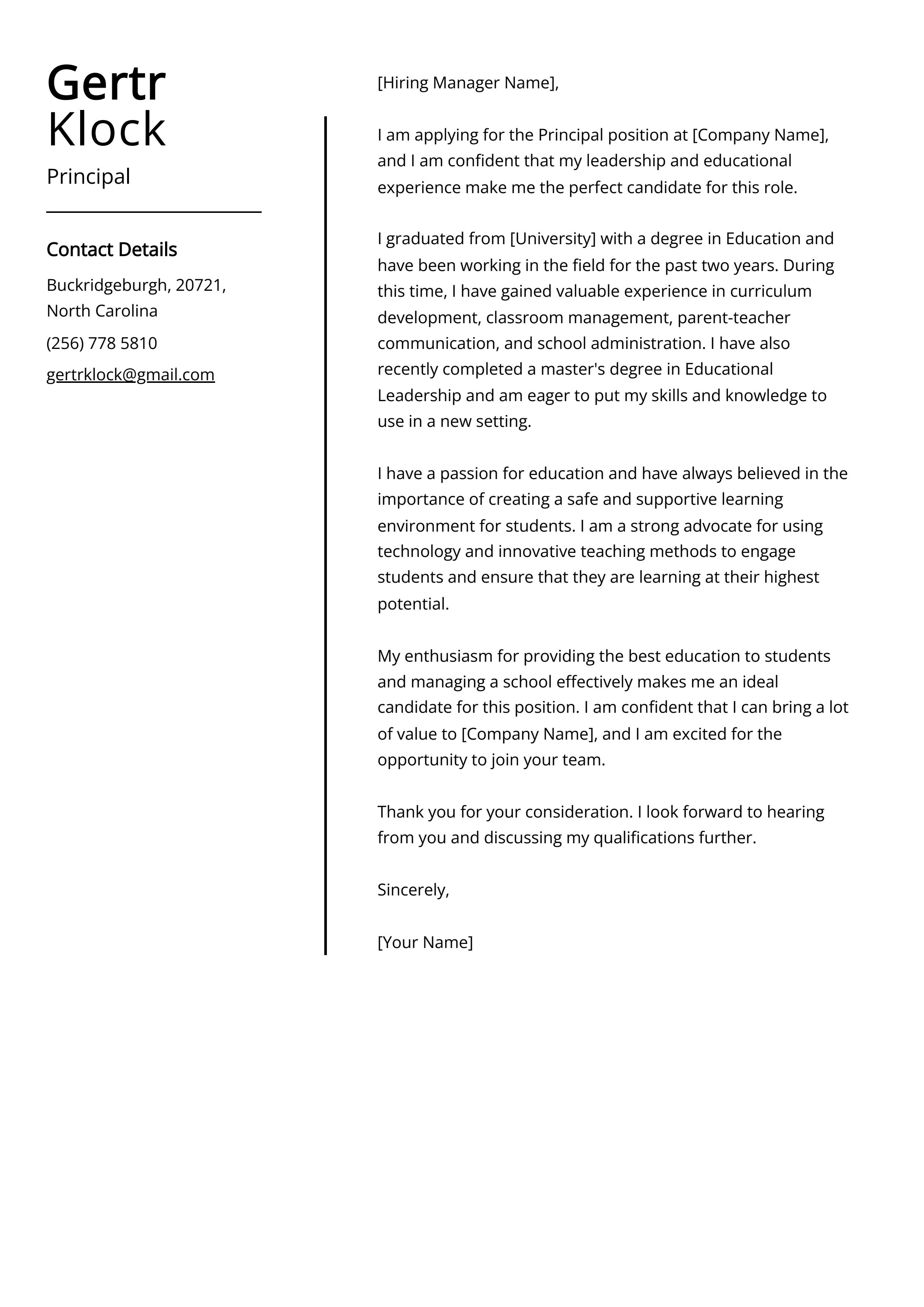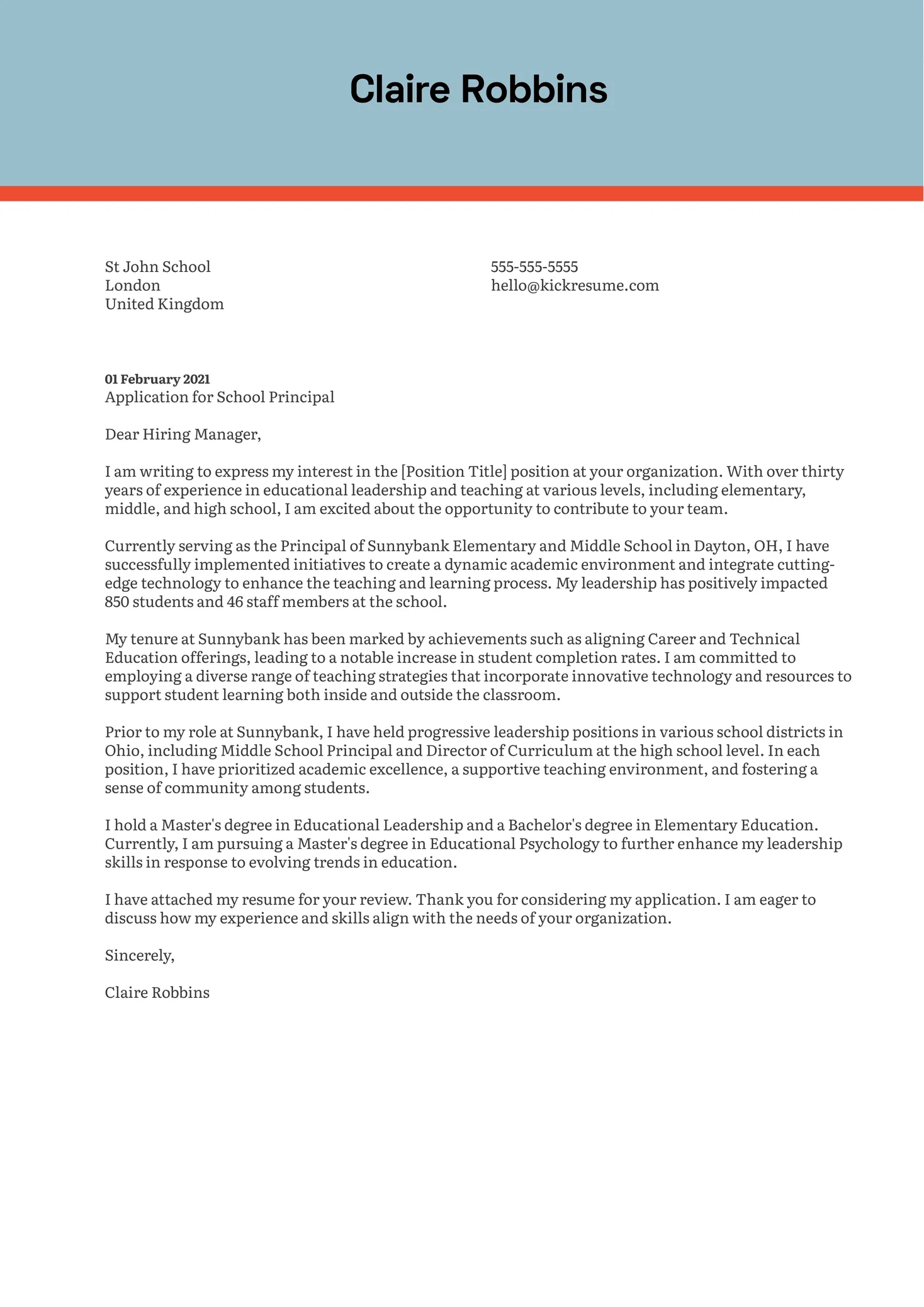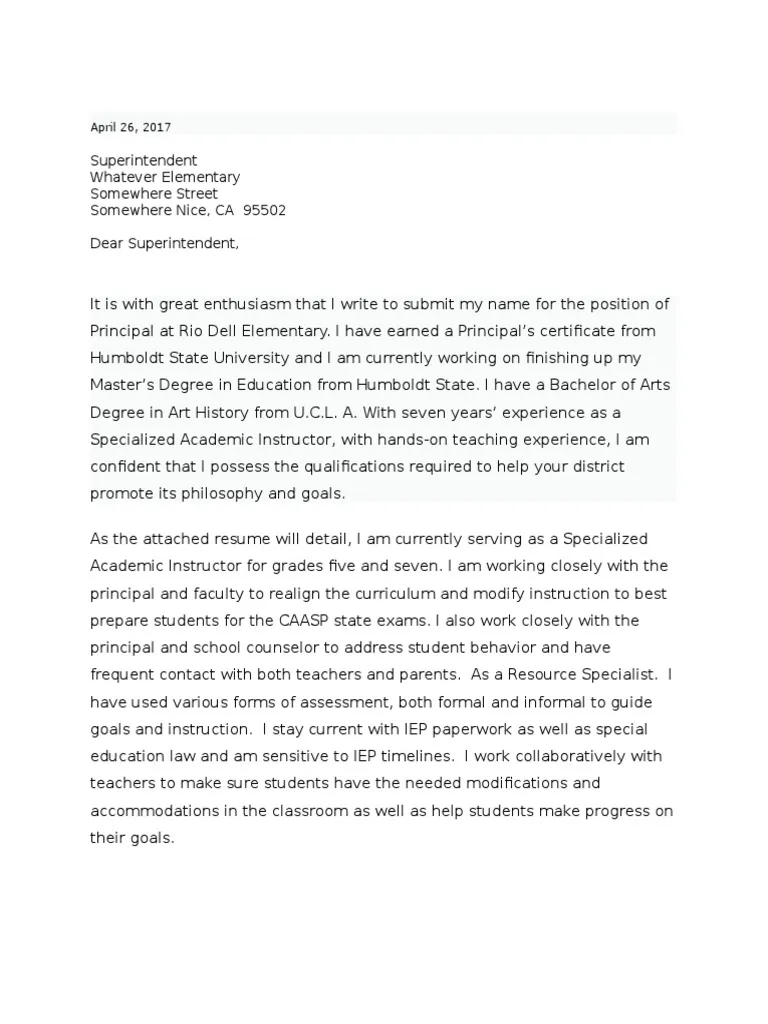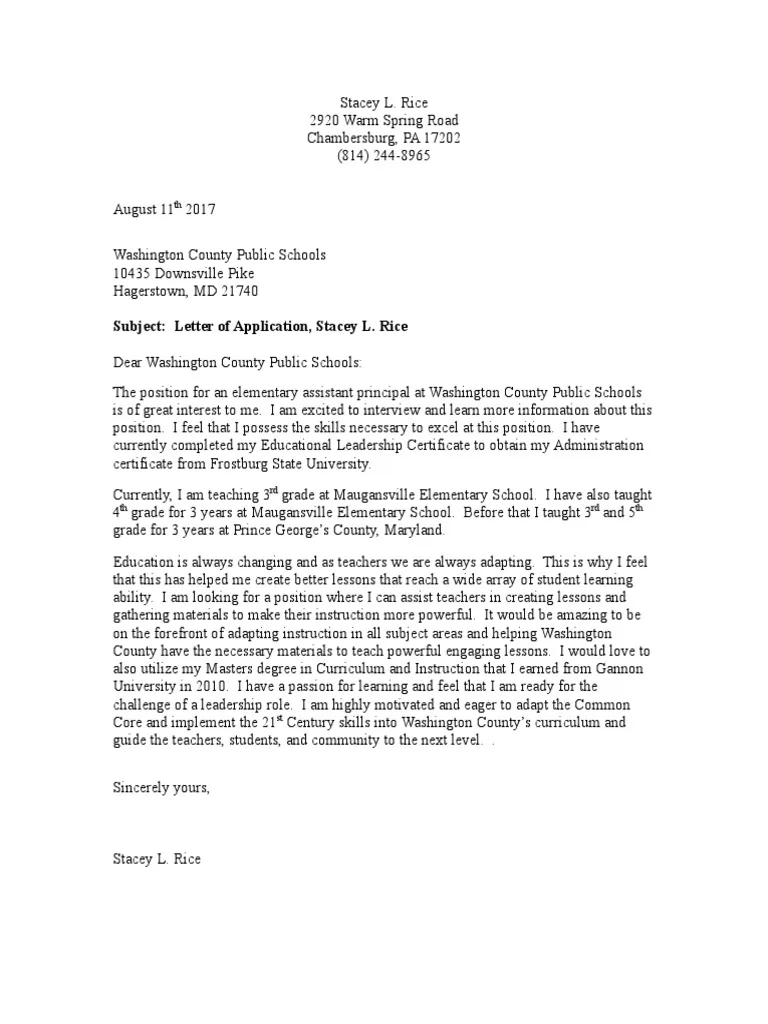Key Elements of a Successful Principal Cover Letter
A well-crafted cover letter is your first opportunity to make a positive impression and secure an interview for a principal position. It’s more than just a formality; it’s a crucial marketing tool that showcases your qualifications, experience, and leadership philosophy. This guide reveals the secrets to crafting a compelling principal cover letter that sets you apart from other candidates. We’ll delve into essential components, formatting tips, and strategies to ensure your letter highlights your strengths and resonates with the hiring committee.
Header and Contact Information
The header of your cover letter is your first opportunity to make a professional statement. It should be clean, well-organized, and immediately convey your contact information. This section ensures the recipient knows who you are and how to reach you easily. Proper formatting demonstrates attention to detail, a critical trait for a principal.
Your Name and Contact Details

Start with your full name, prominently displayed at the top. Include your professional title if you have one (e.g., Dr., Principal, Assistant Principal). Below your name, list your phone number, professional email address, and optionally, a link to your LinkedIn profile or professional website. Ensure your email address is professional and easy to read.
Date and Recipient’s Information
Directly below your contact information, include the date. Then, on the left side, list the recipient’s name (if known), their title, the school name, and the school’s address. If the name of the hiring manager is not available, address your letter to the ‘Hiring Committee’ or ‘Principal Search Committee’.
The Salutation
The salutation sets the tone for your cover letter. A thoughtful and appropriate greeting demonstrates respect and attention to detail. The choice of salutation can vary based on the specific context of the application. Ensure it’s both professional and reflects your knowledge of the school and the position.
Greeting the Hiring Committee

If you are unsure of the specific recipient, use a general but professional salutation. Options include ‘Dear Hiring Committee,’ or ‘Dear Principal Search Committee.’ This approach avoids the impersonal feel of ‘To Whom It May Concern’ while still being inclusive.
Addressing the Specific Recipient
If you know the hiring manager’s name, address your letter directly to them (e.g., ‘Dear Mr. Smith’). This personal touch can help your cover letter stand out. Double-check the spelling of their name and title to ensure accuracy. This shows you’ve taken the time to research and understand the hiring process.
The Body of Your Cover Letter
The body of your cover letter is the core where you present your qualifications, skills, and leadership philosophy. This is your opportunity to connect your experiences to the specific requirements of the principal position and demonstrate why you are the best candidate. Each paragraph should serve a clear purpose, telling a compelling story about your suitability for the role.
Highlighting Your Qualifications

Begin by stating the position you are applying for and expressing your enthusiasm. Briefly mention where you learned about the opening. Then, immediately highlight your key qualifications, matching them to the requirements outlined in the job description. Focus on the skills and experiences most relevant to the role, such as curriculum development, staff management, and student achievement.
Showcasing Relevant Experience
Provide a concise overview of your relevant experience. Describe your previous roles, focusing on responsibilities and accomplishments that align with the principal position. Mention any leadership roles, such as assistant principal, department head, or team leader, and explain how these experiences have prepared you for the principal position. Emphasize your experience working with diverse student populations and fostering inclusive school environments.
Quantifying Achievements and Results
Use data and metrics to support your claims. Quantify your accomplishments whenever possible. For example, instead of saying ‘Improved student test scores,’ state ‘Increased student test scores by 15% within two years through the implementation of a new literacy program.’ Providing concrete evidence of your past successes strengthens your application and showcases your ability to drive results. Use action verbs to start your sentences, like ‘Led’, ‘Developed’, ‘Implemented’, and ‘Managed’. See example image below
Demonstrating Leadership Skills

Principals are first and foremost leaders. Your cover letter should clearly demonstrate your leadership skills and philosophy. Show how you inspire and motivate staff, build collaborative relationships, and create a positive school culture. Mention your ability to make difficult decisions, resolve conflicts, and navigate challenges.
Providing Examples of Leadership
Give specific examples of how you have demonstrated leadership in the past. Share stories that illustrate your leadership style and abilities. For instance, describe a time you successfully led a school improvement initiative, mentored a struggling teacher, or resolved a conflict among staff members. These anecdotes bring your qualifications to life and allow the hiring committee to visualize you in the principal role.
Mentioning Community Involvement
Highlight any involvement in the school community. This includes participation in parent-teacher organizations, community outreach programs, or local educational initiatives. Community engagement demonstrates your commitment to creating a supportive environment for students and families. Principals who build strong relationships with the community often see higher levels of support for their schools. This demonstrates a commitment to the school and the community it serves. See example image below.
Expressing Enthusiasm and Fit

Convey your genuine enthusiasm for the principal position and the specific school. Show that you understand the school’s mission, values, and goals. Explain why you are excited about the opportunity to contribute to the school’s success and how your skills and experience align with its needs.
Articulating Your Vision
Briefly articulate your vision for the school. What do you hope to achieve as principal? How will you lead the school to improve student outcomes, foster a positive learning environment, and support the professional growth of staff? Demonstrate your understanding of current educational trends, challenges, and opportunities. Show your commitment to continuous improvement and innovation.
Demonstrating Cultural Alignment
Show how your leadership style and values align with the school’s culture. This includes mentioning any experience working in similar school environments or demonstrating an understanding of the school’s specific needs and priorities. Research the school and its values, and tailor your cover letter to reflect that you are a good fit. Make sure your leadership style resonates with the school’s ethos. See example image below.
The Closing

The closing of your cover letter provides an opportunity to express your interest, show gratitude, and include a call to action. It’s your last chance to reinforce your message and encourage the hiring committee to contact you.
Formal Closing and Signature
Use a formal closing such as ‘Sincerely,’ ‘Respectfully,’ or ‘Yours sincerely.’ Leave space for your handwritten signature, if you plan on printing the letter. Below your signature, type your full name. This reinforces the professionalism of your application.
Reiterating Interest and Gratitude
Reiterate your interest in the principal position and express your gratitude for the hiring committee’s time and consideration. Thank them for reviewing your application and acknowledge the opportunity to be considered. This demonstrates courtesy and reinforces your eagerness for the role. Be sure to check the image below.
Including a Call to Action
Include a call to action, such as ‘I am eager to discuss my qualifications further and would welcome the opportunity for an interview.’ Provide your contact information again and express your availability for an interview. This encourages the hiring committee to take the next step and contact you.
Essential Formatting and Proofreading
Formatting and proofreading are critical steps to ensure your cover letter is professional and polished. A well-formatted and error-free letter reflects your attention to detail and commitment to excellence. These elements significantly impact the overall impression you make.
Formatting Guidelines
Adhering to formatting guidelines ensures your cover letter is easy to read and visually appealing. Choose a professional font, use consistent spacing, and maintain a clean layout. These formatting choices make your letter more reader-friendly and reflect your commitment to professionalism.
Font and Spacing Recommendations
Use a standard, easy-to-read font such as Times New Roman, Arial, or Calibri, sized between 11 and 12 points. Use single-spacing within paragraphs and double-spacing between paragraphs. Maintain consistent margins (typically 1 inch on all sides). Avoid using excessive formatting, and keep the layout clean and organized. Use images below to improve readability
Proofreading and Editing
Proofreading and editing are essential to eliminate errors and ensure your cover letter is flawless. Even minor mistakes can undermine your credibility. A carefully proofread letter demonstrates your attention to detail, which is vital for a principal position.
Checking for Grammar and Spelling
Thoroughly check your cover letter for grammar and spelling errors. Use a spell checker and grammar checker, but do not rely on them entirely. Read the letter carefully multiple times, and read it out loud to catch any errors. Ensure that all punctuation and capitalization are correct. Errors can suggest a lack of attention to detail.
Seeking Feedback from Others
Ask trusted colleagues, mentors, or career advisors to review your cover letter. Fresh eyes can identify errors or suggest improvements you might have missed. Their feedback can help you refine your cover letter, making it even more effective. Proofreading and editing is important to ensure your cover letter is free of errors. See images below
